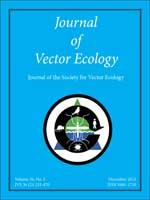A number of mosquito species avoid predator-inhabited oviposition sites by detecting predator-released kairomones. In the laboratory, we found that when offered de-ionized water and de-ionized water conditioned with Notonecta maculata, gravid Anopheles gambiae females preferentially oviposited into the former. We then conducted further experiments using two chemical components found in Notonecta-conditioned water, chemically pure n-tricosane and/or n-heneicosane, that was previously shown to repel oviposition by Culiseta longiareolata. These hydrocarbons failed to deter oviposition by An. gambiae females. Thus, different mosquito species may rely on distinct chemical cues to avoid predators. Identification and chemical characterization of such kairomones could facilitate innovative, environmentally sound mosquito control.
How to translate text using browser tools
1 December 2011
Oviposition Habitat Selection by Anopheles gambiae in Response to Chemical Cues by Notonecta Maculata
Alon Warburg,
Roy Faiman,
Alex Shtern,
Alon Silberbush,
Shai Markman,
Joel E. Cohen,
Leon Blaustein
ACCESS THE FULL ARTICLE
It is not available for individual sale.
This article is only available to subscribers.
It is not available for individual sale.
It is not available for individual sale.

Journal of Vector Ecology
Vol. 36 • No. 2
December 2011
Vol. 36 • No. 2
December 2011
Anopheles gambiae
kairomones
mosquitoes predators
notonectid bugs
oviposition
predation




